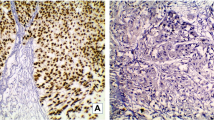Abstract
Introduction
The aim of the study was to evaluate the status of Her2/neu protein expression in patients with muscle-invasive urothelial carcinomas of the bladder treated with radical cystectomy and to determine its prognostic significance.
Material and methods
We retrospectively analyzed the data of 90 patients who had undergone cystectomy for invasive transitional cell carcinoma of the urinary bladder. Immunohistochemical analysis for Her2/neu was done on paraffin-fixed tissues with CB11 antibodies (BioGenex, San Ramon, CA, USA). Sections with grade 2 and grade 3 staining were considered positive for Her2/neu.
Results
Over a median follow-up period of 46 months (24–96 months) 46 patients are living without disease recurrence and six with recurrent disease either at the local site or with distant metastases. The remaining 38 patients have died. The median overall survival time was 50 months, and median disease-free survival time was 40 months. The Her2/neu status was significantly related to the tumor stage (P = 0.001), lymph node involvement (77% in N+ vs 23% in N0; P = 0.001) and the grade of the disease (32% of grade 2 vs 71% of grade 3; P = 0.037). Kaplan–Meier curves showed a significantly worse disease-related survival period (log rank P = 0.011) for patients with Her2 overexpressing tumors than for those without overexpression. In addition to tumor stage [P = 0.001; relative risk (RR) = 2.62] and lymph node status (P = 0.0001; RR = 2.95), Her2 status (P = 0.020; RR = 2.22) was identified as an independent predictor for disease-related survival in a multivariate analysis.
Conclusion
These results suggest that Her2 expression might provide additional prognostic information for patients with muscle-invasive bladder cancer. Future studies on Her2 expression with chemosensitivity and the efficacy of Her2-targeted therapies in urothelial carcinomas are warranted.


Similar content being viewed by others
References
Stein JP, Lieskovsky G, Cote R et al (2001) Radical cystectomy in the treatment of bladder cancer: long-term results in 1054 patients. J Clin Oncol 19:666–675
Yamamoto T, Ikawa S, Akiyama T et al (1986) Similarity of protein encoded by the human c-erb-B2 gene to epidermal growth factor receptor. Nature (London) 319:230–234
Graus-Porta D, Beerli RR, Daly JM, Hynes NE (1997) ErbB-2, the preferred heterodimerization partner of all ErbB receptors, is a mediator of lateral signaling. EMBO J 16:1647–1655
Stern DF (2000) Tyrosine kinase signaling in breast cancer; ErbB family receptor tyrosine kinase. Breast Cancer Res 2:176–183
McCann A, Dervan PA, Johnston PA et al (1990) C-erbB-2 oncoprotein expression in primary human tumors. Cancer 65:88–92
Zhau HE, Zhang X, von Eschenbach AC et al (1990) Amplification and expression of the c-erb B2/neu proto-oncogene in human bladder cancer. Mol Carcinog 3:254–257
Kruger S, Weitsch G, Buttner H et al (2001) Overexpression of c-erbB-2 oncoprotein in muscle-invasive bladder carcinoma: relationship with gene amplification, clinicopathological parameters and prognostic outcome. Int J Oncol 21:981–987
Hermanek P, Sobin LH (1987) TNM classification of urinary bladder tumours, 4th edn. Springer, New York
Mostofi FK, Sobin LH, Torloni H (1973) Histological typing of urinary bladder tumours. World Health Organization, Geneva
Olayioye MA, Neve RM, Lane HA, Hynes NE (2000) The ErbB signaling network: receptor heterodimerization in development and cancer. EMBO J 19:3159–3167
Lu Z, Jiang G, Blume-Jensen P, Hunter T (2001) Epidermal growth factor-induced tumor cell invasion and metastasis initiated by dephosphorylation and downregulation of focal adhesion kinase. Mol Cell Biol 21:4016–4031
Gandour-Edwards R, Lara PN Jr, Folkins AK et al (2002) Does Her2/neu expression provide prognostic information in patients with advanced urothelial carcinoma? Cancer 95:1009–1015
Underwood M, Bartlett J, Reeves J et al (1995) C-erbB-2 gene amplification: a molecular marker in recurrent bladder tumors? Cancer Res 55:2422–2430
Jimenez RE, Hussain M, Bianco FJ Jr et al (2001) HER2 overexpression in muscle-invasive urothelial carcinoma of the bladder: prognostic significance and comparative analysis in primary and metastatic tumors. Clin Cancer Res 7:2440–2447
Cobleigh MA, Vogel CL, Tripathy D et al (1999) Multinational study of the efficacy and safety of humanized anti-HER2 monoclonal antibody in women who have HER2-overexpressing metastatic breast cancer that has progressed after chemotherapy for metastatic disease. J Clin Oncol 17:2639–2648
Salmon D, Leyland-Jones B, Shak S et al (1998) Addition of Herceptin to first line chemotherapy for Her2 over expressing metastatic breast cancer markedly increases anticancer activity: a randomized multinational controlled phase III trial. Proc Am Soc Clin Oncol 17:98
Lebeau A, Deimling D, Kaltz C et al (2001) HER2 analysis in archival tissue samples of human breast cancer: comparison of immunohistochemistry and fluorescence in situ hybridization. J Clin Oncol 19:354–363
Schraml P, Kononen J, Bubendorf L et al (1999) Tissue microarrays for gene amplification surveys in many different tumor types. Clin Cancer Res 5:1966–1975
Miyamoto H, Kubota Y, Noguchi S et al (2000) C-erbB-2 gene amplification as a prognostic marker in human bladder cancer. Urology 55:679–683
Lonn U, Lonn S, Friberg S et al (1995) Prognostic value of amplification of c-erb-B2 in bladder carcinoma. Clin Cancer Res 1:1189–1194
Pegram MD, Lipton A, Hayes DF et al (1998) Phase II study of receptor-enhanced chemosensitivity using recombinant humanized anti-p185HER2/neu monoclonal antibody plus cisplatin in patients with HER2/neu-overexpressing metastatic breast cancer refractory to chemotherapy treatment. J Clin Oncol 16:2659–2671
Bacus SS, Gudkov AV, Lowe M et al (2001) Taxol-induced apoptosis depends on mitogen activated protein kinase (MAP-K) pathways (ERK and p38) and is independent of p53. Oncogene 20:147–155
Author information
Authors and Affiliations
Corresponding author
Rights and permissions
About this article
Cite this article
Kolla, S.B., Seth, A., Singh, M.K. et al. Prognostic significance of Her2/neu overexpression in patients with muscle invasive urinary bladder cancer treated with radical cystectomy. Int Urol Nephrol 40, 321–327 (2008). https://doi.org/10.1007/s11255-007-9283-x
Received:
Accepted:
Published:
Issue Date:
DOI: https://doi.org/10.1007/s11255-007-9283-x




